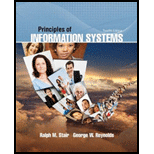
Principles of Information Systems (MindTap Course List)
12th Edition
ISBN: 9781285867168
Author: Ralph Stair, George Reynolds
Publisher: Cengage Learning
expand_more
expand_more
format_list_bulleted
Question
Chapter 10, Problem 8RQ
Program Plan Intro
Computer based
Computer Based Information System (CBIS) denotes a data processing system into high-quality information and could be used as a tool that supports visualization, analysis, decision-making, control and co-ordination.
Types of computer based information system:
- Management Information System (MIS):
- A management information system is an organized collection for software,
database , devices, people, and procedures. - It provides routine information to managers and decision makers.
- A management information system is an organized collection for software,
- Transaction Processing System (TPS):
- A transaction processing system denotes a kind of information system.
- It gathers, stores, retrieves and alters enterprise’s data transactions.
- Executive Support System (ESS):
- It denotes a management support system type that would enable and cares senior executive information.
- It supports for requirements of decision-making.
- Decision Support System (DSS):
- It inclines to be aimed at less well-structured problem confronted by upper level managers.
- It efforts to combine usage of models or techniques with functions of data access as well as retrieval.
Expert Solution & Answer
Want to see the full answer?
Check out a sample textbook solution
Students have asked these similar questions
Dijkstra's Algorithm (part 1). Consider the network shown below, and Dijkstra’s link-state algorithm. Here, we are interested in computing the least cost path from node E (note: the start node here is E) to all other nodes using Dijkstra's algorithm. Using the algorithm statement used in the textbook and its visual representation, complete the "Step 0" row in the table below showing the link state algorithm’s execution by matching the table entries (i), (ii), (iii), and (iv) with their values. Write down your final [correct] answer, as you‘ll need it for the next question.
4. |z + 5 - 5i| = 7
14.
dz,
C: |z❘
C: |z❘ = 0.6
ze² - 2iz
H
Chapter 10 Solutions
Principles of Information Systems (MindTap Course List)
Ch. 10.6 - Prob. 1DQCh. 10.6 - Prob. 2DQCh. 10.6 - Prob. 1CTQCh. 10.6 - Prob. 2CTQCh. 10.9 - Prob. 1DQCh. 10.9 - Prob. 2DQCh. 10.9 - Prob. 1CTQCh. 10.9 - Prob. 2CTQCh. 10 - During which stage of the problem-solving process...Ch. 10 - The three stages of decision making are augmented...
Ch. 10 - Prob. 3SATCh. 10 - Prob. 4SATCh. 10 - Prob. 5SATCh. 10 - Prob. 6SATCh. 10 - Prob. 7SATCh. 10 - Prob. 8SATCh. 10 - Prob. 9SATCh. 10 - Prob. 10SATCh. 10 - Prob. 11SATCh. 10 - The ______ approach is a structured, interactive,...Ch. 10 - Prob. 13SATCh. 10 - Prob. 14SATCh. 10 - Prob. 1RQCh. 10 - Prob. 2RQCh. 10 - Prob. 3RQCh. 10 - Prob. 4RQCh. 10 - Prob. 5RQCh. 10 - Prob. 6RQCh. 10 - Prob. 7RQCh. 10 - Prob. 8RQCh. 10 - Prob. 9RQCh. 10 - Prob. 10RQCh. 10 - Prob. 11RQCh. 10 - Prob. 12RQCh. 10 - Prob. 13RQCh. 10 - Prob. 14RQCh. 10 - Prob. 15RQCh. 10 - Prob. 16RQCh. 10 - Prob. 17RQCh. 10 - Prob. 1DQCh. 10 - Prob. 2DQCh. 10 - Prob. 3DQCh. 10 - Prob. 4DQCh. 10 - Prob. 5DQCh. 10 - Prob. 6DQCh. 10 - Prob. 7DQCh. 10 - Prob. 8DQCh. 10 - Prob. 9DQCh. 10 - Prob. 10DQCh. 10 - Prob. 1PSECh. 10 - Prob. 1TACh. 10 - Prob. 2TACh. 10 - Prob. 3TACh. 10 - Prob. 1WECh. 10 - Prob. 2WECh. 10 - Prob. 3WECh. 10 - Prob. 1CECh. 10 - Prob. 2CECh. 10 - Prob. 1DQ1Ch. 10 - Prob. 2DQ1Ch. 10 - Prob. 1CTQ1Ch. 10 - Prob. 2CTQ1Ch. 10 - Prob. 1DQ2Ch. 10 - Prob. 2DQ2Ch. 10 - Prob. 1CTQ2Ch. 10 - Prob. 2CTQ2Ch. 10 - Prob. 1DQ3Ch. 10 - Prob. 2DQ3Ch. 10 - Prob. 1CTQ3Ch. 10 - Prob. 2CTQ3
Knowledge Booster
Similar questions
arrow_back_ios
SEE MORE QUESTIONS
arrow_forward_ios
Recommended textbooks for you
 Fundamentals of Information SystemsComputer ScienceISBN:9781305082168Author:Ralph Stair, George ReynoldsPublisher:Cengage Learning
Fundamentals of Information SystemsComputer ScienceISBN:9781305082168Author:Ralph Stair, George ReynoldsPublisher:Cengage Learning Management Of Information SecurityComputer ScienceISBN:9781337405713Author:WHITMAN, Michael.Publisher:Cengage Learning,
Management Of Information SecurityComputer ScienceISBN:9781337405713Author:WHITMAN, Michael.Publisher:Cengage Learning, Principles of Information Systems (MindTap Course...Computer ScienceISBN:9781305971776Author:Ralph Stair, George ReynoldsPublisher:Cengage Learning
Principles of Information Systems (MindTap Course...Computer ScienceISBN:9781305971776Author:Ralph Stair, George ReynoldsPublisher:Cengage Learning Enhanced Discovering Computers 2017 (Shelly Cashm...Computer ScienceISBN:9781305657458Author:Misty E. Vermaat, Susan L. Sebok, Steven M. Freund, Mark Frydenberg, Jennifer T. CampbellPublisher:Cengage Learning
Enhanced Discovering Computers 2017 (Shelly Cashm...Computer ScienceISBN:9781305657458Author:Misty E. Vermaat, Susan L. Sebok, Steven M. Freund, Mark Frydenberg, Jennifer T. CampbellPublisher:Cengage Learning

Fundamentals of Information Systems
Computer Science
ISBN:9781305082168
Author:Ralph Stair, George Reynolds
Publisher:Cengage Learning


Management Of Information Security
Computer Science
ISBN:9781337405713
Author:WHITMAN, Michael.
Publisher:Cengage Learning,

Principles of Information Systems (MindTap Course...
Computer Science
ISBN:9781305971776
Author:Ralph Stair, George Reynolds
Publisher:Cengage Learning

Enhanced Discovering Computers 2017 (Shelly Cashm...
Computer Science
ISBN:9781305657458
Author:Misty E. Vermaat, Susan L. Sebok, Steven M. Freund, Mark Frydenberg, Jennifer T. Campbell
Publisher:Cengage Learning
